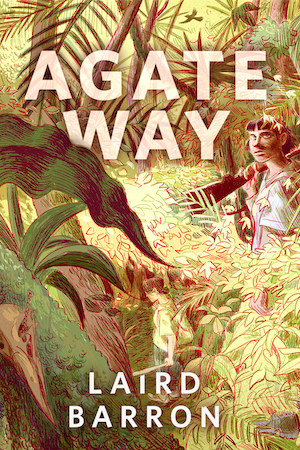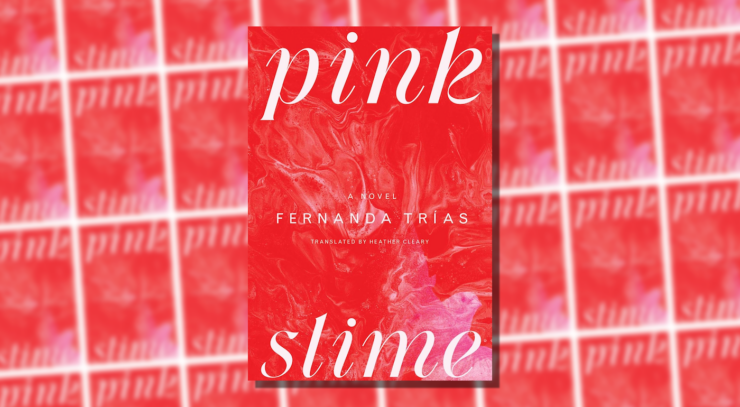Pink Slime unfolds in my hands with a customary string of lively blurbs, one invoking the well-worn name of J.G. Ballard, which can sometimes be a crapshoot in this current age of Total Marketing where quick associations and categorization can feel like a set of jingling keys. So it’s extra satisfying that Pink Slime’s flavor of Ballardianism turns out to be devastatingly true. Fernanda Trías’s neat, visceral prose (translated from the Spanish by Heather Cleary) bears a distinctly cinematic quality that consumes the page and my mind’s eye and whole little reading bubble; her protagonist moves through damp fog and distant neon with a visual fluency that makes my first taste of Pink Slime effortlessly atmospheric.
Dystopian themes of isolation and psychopathology aside, perhaps Pink Slime aligns so easily with the Ballardian label because it shares Ballard’s fondness of wielding the short story to dissect single subjects. Set in an alternate version of Uruguay, Pink Slime broadly observes similar constraints with a much more melancholy sense of intimacy and pathos. Its unnamed protagonist lives in the aftermath of an environmental catastrophe—the red wind—that has poisoned the air with toxins and a strange plague. To get by, she babysits a disabled boy, Mauro, whose indifferent, wealthy parents drop him off with cash and food; Mauro has a rare genetic condition that makes him constantly, endlessly hungry, and has trouble communicating and functioning normally. Max, the protagonist’s ex-husband, is afflicted by the disease, but confined to the safety of a government facility called Clinics. And then there’s her mother, reduced to a small life in the decaying suburbs, difficult in the way that all mothers are, who chafes against her daughter’s plan to leave for Brazil.
Trías uses these bound spaces to create a highly effective sense of claustrophobia informed by pandemic protocols and the encroaching nightmare of climate change; the inhabitants of Pink Slime’s city track the weather so they know when to seal themselves indoors with fake-meat rations and stale air. Their new normal is a filthy, soupy fog that leaches color from the world, but also offers temporary safety from the red wind. There is clearly a lot about this that speaks to our current place in time, but Pink Slime is primarily concerned with the interiority of its protagonist and her slow, quiet struggle away from stasis; she reflects on the way we rationalize and justify our own actions when perhaps all we need to do is accept that our lives are simply driven by chance or inertia. In this protagonist and her pseudo-fatalist connection to Max, Trías paints a somber picture of two people tethered together with the weight of circumstance and past baggage, where one is perhaps clinging to the other a little too tightly. We get glimpses of this relationship in flashbacks and Clinics visits, and Trías here does a powerful job of capturing the faintly sweet stagnation of sentimentality and nostalgia that affects—and limits—us all.
Buy the Book


Pink Slime
Perhaps the most interesting thing about the book is Trías’s presentation of Mauro, who mostly exists on the page without the usual allegory and metaphor that one might usually apply to an almost non-verbal character defined by their syndrome. The protagonist is consumed by the intensity of Mauro’s care when she has him, but Trías, by the end of the book, lets the reader sit with their own biases and thoughts on this abnormally large, difficult child completely driven by one overriding impulse and his relationship with the protagonist, or perhaps his analog function as a force of nature—if that suits the reader better. If the protagonist is a willing victim of life-as-inertia, then Mauro is the force that pushes her out of that familiar cycle of promise and procrastination. Trías’s approach and style is too elegant to have Mauro exist as a base metaphor for the sort of hypercapitalist, hyperconsumptive culture that pushed Pink Slime into existence—a mouth with no direction—but this sort of ambiguity in fiction is best left to sit privately inside the reader’s head, to be combed through like a knot and left alone to ferment in the subconscious.
If anything, Pink Slime forces me to examine my own relationship with inertia, like a hand gripping the crown of my head and swiveling it toward something I’d rather let sit just out of view. Trías writes an all-too-relatable protagonist with an incisiveness that makes me sit with my own sad little idiosyncrasies and the things I let myself believe stand in the way of moving forward. I think of the protagonist stumbling upon a small trove of treasure—old cans of tuna—and the glorious sensation of taking in the scent and taste of an extinct animal. I think of the snippy exchanges she has with her mother, clinging on to the last vestiges of middle-class life in a decaying neighborhood where residents would rather pay people like her to live in their houses than allow homeless people to move in.
Trías has preserved a crisp snapshot in time of this woman’s life with a beautifully understated sense of cinematic style and nuance that one sees more often in short stories (more so international, non-western short stories), and this, above all the obvious Ballardian hallmarks of bourgeois degeneration and societal compartmentalization, is the heart of what brings Pink Slime into this particular fold.
Pink Slime is published by Scribner.










